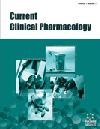- Home
- A-Z Publications
- Current Clinical Pharmacology
- Previous Issues
- Volume 1, Issue 2, 2006
Current Clinical Pharmacology - Volume 1, Issue 2, 2006
Volume 1, Issue 2, 2006
-
-
The Imaging of Apoptosis with the Radiolabelled Annexin A5: A New Tool in Translational Research
More LessAuthors: Tarik Z. Belhocine and Francis G. BlankenbergProgrammed cell death also called apoptosis plays a pivotal role in many physiological and pathological conditions. In the multi-step process of drug development, a number of medications are being designed to target strategic checkpoints of the apoptotic cascade either to induce or to inhibit programmed cell death. Conceptually, the assessment of programmed cell death in response to various therapeutic interventions appe Read More
-
-
-
Clinical Experience with the Use of Angiotensin Receptor Blockers in Patients with Cardiovascular, Cerebrovascular and Renal Diseases
More LessThe Angiotensin II receptor blockers (ARBs) have been efficacious and safe drugs for the treatment of hypertension, heart failure, diabetic nephropathy and stroke from several short and long term clinical trials. The ARBs exert their effects through selective blockade of the angiotensin II (Ang-II) subtype 1 (AT1) receptor and quite possibly through stimulation by Ang-II of the unoccupied subtype 2 (AT2) receptor. The ARBs Read More
-
-
-
The Case of Biotech-Derived Product Equivalence: Much Ado About Nothing?
More LessThe potential marketplace for biotech-derived products from different bioprocess modifications looms large. However, there is the widespread view that, for biopharmaceuticals, the process makes the product. The current practice includes the physic-chemical and biological tests required to demonstrate structural equivalence of both products, the assessment of the potential impact of process changes on the biological qualit Read More
-
-
-
Effect of Grapefruit Juice in Relation to Human Pharmacokinetic Study
More LessAuthors: Tsukasa Uno and Norio Yasui-FurukoriGrapefruit juice (GFJ) interacts with a number of drugs, and can alter pharmacokinetics parameters of the drugs. As for these interactions, most reports have focused on the elevation of drug bioavailability by GFJ, but a few recent reports have indicated that GFJ reduced the absorption of drugs not metabolized by cytochrome P450 (CYP). The predominant mechanisms of GFJ-drug interaction are thought to be due primarily Read More
-
-
-
Application of Microdialysis in Clinical Pharmacology
More LessAuthors: Christian Hocht, Javier A.W. Opezzo, Guillermo F. Bramuglia and Carlos A. TairaMicrodialysis has been developed during the last 25 years by several authors primarily to study brain function and changes in levels of endogenous compounds such as neurotransmitters or metabolites in different laboratory animals. However, in the last ten years microdialysis sampling has been introduced as a versatile technique in the clinical setting. Although, microdialysis sampling has been extensively used for metabolic Read More
-
-
-
The Applications of Biomarkers in Early Clinical Drug Development to Improve Decision-Making Processes
More LessAuthors: Jochen Kuhlmann and Georg WensingSelecting, evaluating and applying biomarkers in drug discovery and exploratory drug development do substantially shorten the time to reach a critical decision point. Biomarkers are most useful in the early phase of clinical development when measurement of clinical endpoints or true surrogates may be too time-consuming or cumbersome to provide timely proof of principle or dose-ranging information. The use of bio Read More
-
-
-
Pharmacokinetic Changes of Drugs in Rat Model of Acute Renal Failure Induced by Uranyl Nitrate: Correlation Between Drug Metabolism and Hepatic Microsomal Cytochrome P450 Isozymes
More LessAuthors: Myung G. Lee, Joo H. Lee and Jung M. OhIn male Sprague-Dawley rat model of acute renal failure induced by uranyl nitrate (rat model of U-ARF), the expression of CYP2C11 decreased by 20% of control, whereas that of CYP2E1 and 3A1(23) increased 2-4 and 4 times, respectively, as compared with controls. The expressions of CYP1A2 and 2B1/2 were not changed by U-ARF. The mRNA level of CYP2E1 increased 3 times and that of CYP2C11 decreased to 25% of Read More
-
-
-
The Diagnosis of Drug-Induced Liver Disease
More LessAuthors: Pedro Zapater, Rocio Moreu and Jose F. HorgaThe diagnosis of drug-induced liver injury is often one of exclusion with initial suspicion based on circumstantial evidence. The natural history, characteristics and limitations of this exclusion process are revised. Also, the numerous published attribution algorithms for evaluation of drug-related liver abnormalities are described and their characteristics and differences are illustrated with true patients from our clinical expe Read More
-
Volumes & issues
Most Read This Month
Article
content/journals/ccp
Journal
10
5
false
en


